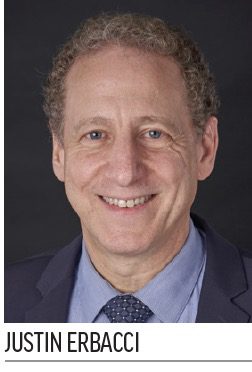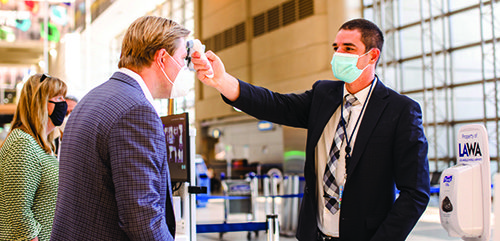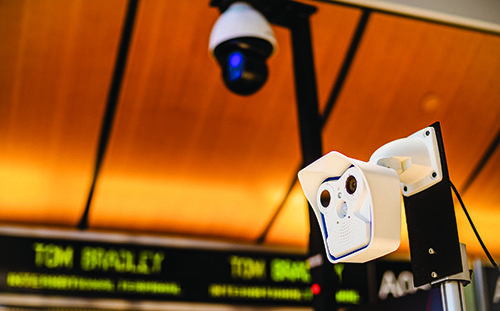From the very onset of the COVID-19 crisis, Los Angeles World Airports has been aggressively pursuing new processes, protocols and technologies to keep Los Angeles International Airport (LAX) clean, healthy and safe for employees, tenants and passengers.
From the very onset of the COVID-19 crisis, Los Angeles World Airports has been aggressively pursuing new processes, protocols and technologies to keep Los Angeles International Airport (LAX) clean, healthy and safe for employees, tenants and passengers.
 Armed with information from the Los Angeles County Department of Health and the Centers for Disease Control and Prevention (CDC), the Airport Authority immediately upgraded sanitization procedures in response to the novel coronavirus outbreak. More frequent deep cleaning of high-traffic areas is now complemented by focused cleaning of high-touch areas such as handrails and elevator buttons.
Armed with information from the Los Angeles County Department of Health and the Centers for Disease Control and Prevention (CDC), the Airport Authority immediately upgraded sanitization procedures in response to the novel coronavirus outbreak. More frequent deep cleaning of high-traffic areas is now complemented by focused cleaning of high-touch areas such as handrails and elevator buttons.
Throughout the terminals and concourses, stations with hand sanitizer are dispensing hundreds upon hundreds of commercial-size drums of product; and ultraviolet technology silently sanitizes the air flowing throughout the airport’s state-of-the-art ventilation systems.
|
Project: Pilot Use of Thermal Imaging Cameras Location: Los Angeles Int’l Airport Airport Authority: Los Angeles World Airports Objective: Identify passengers with elevated body temperatures to detect possible carriers of COVID-19 Pilot Duration: 12 weeks Initial Equipment Installation: June Cost to Airport Authority: $0 for technology consulting, equipment & installation; 80$/hr for medical support contractors, not to exceed $150,000 Funding: Authority is using operational reserves to pay for medical support & will apply for reimbursement from FEMA Primary Contractors: Carlyle Airport Group; Schneider Electric Technology Support: Faith Group; Atkins Digital Signage & Totems: Synect Equipment Mfrs: Electro Optical Industries; Intellisite; Omnisense Systems Contracted Medical Personnel: Concentra Other Contributors: TSA; CDC; LA County Dept. of Health Key Benefits: Help prevent guests infected with COVID-19 from spreading it to other guests & staff Strategy: Thermal imaging cameras allow airport to take passengers’ temperatures as they pass through entrances, without asking them to stop or interact with/touch staff |
“We are always looking for ways to make our facilities cleaner and healthier,” says Justin Erbacci, chief executive officer for Los Angeles World Airports. “We just keep adding more and more layers as we find something new that we can do.”
Signage and media announcements help keep passengers informed about the airport’s rapidly evolving response measures, including a policy instituted in May that requires them to wear a face covering in all LAX terminals. Masks, bandanas, scarves and T-shirts held in place are all considered acceptable. The requirement for passengers and visitors was an extension of an earlier policy mandating face covering for Airport Authorities employees and tenants.
Temperature Screenings
More recently, LAX began the pilot use of thermal imaging to detect guests with fevers over 100.4 degrees Fahrenheit—a common symptom of COVID-19. The airport is testing three different thermal cameras to identify the best technology, associated secondary screening methods and operational procedures.
Erbacci explains that Los Angeles World Airports has been on a quest to prevent people who may have the virus from entering its facilities and interacting with those who are not infected. Although a growing number of LAX tenant airlines and other businesses conduct individual temperature checks with handheld digital thermometers, the Airport Authority wanted a more comprehensive and standardized method to screen for symptomatic guests at the world’s third-busiest airport. Health authorities strongly recommend that people with a fever not travel.
“We cannot test every single person individually before they walk in,” Erbacci says, noting that more than 44 million passengers departed LAX last year. Administering individual temperature checks, much less actual COVID-19 tests, is simply not possible given the scale, time and capacity that effort would require.
“But we have tried to find something that would allow us to add another layer of protection,” he adds.
Thermal imaging, the extra layer LAX is testing, is just one technology that can be used to identify enhanced body temperature. Airport personnel researched several options, but honed in on thermal cameras because they allow LAX to conduct wide-scale temperature checks without touching passengers or asking them to wait in line.
The models being tested are the Mobotix Camera System from Intellisite, the HGH Spynel camera from Omnisense Systems and another Omnisense unit with analytics support through S2 Global.
In June, crews installed one of the cameras inside the main entrance of the departures level in the Tom Bradley International Terminal. The other cameras will be rotated for testing in that terminal or another terminal entrance. Each camera will be tested according to FDA recommendations for accuracy, range, field of view and other metrics. Testers will also compare the cameras’ user interface and their ability to produce meaningful reports of the summary data.
The 12-week trial, known as the LAX Terminal Wellness Pilot Program, has engendered notable in-kind support from several companies within the industry.
Pro Bono Partners
Los Angeles World Airports is executing the pilot program in collaboration with the Carlyle Airport Group through Schneider Electric, which is providing the cameras and also assisted with installation. The equipment being tested, worth about $400,000, is on loan at no cost. Faith Group is evaluating the technology and providing signage, also at no cost.
Carlyle Airport Group, an airport infrastructure investment firm headquartered in Washington, D.C., was inspired to participate because its executives saw the need for “extraordinary cooperation and decisive response to retool and rebuild passenger confidence in air travel.”
 “As the leader in public-private partnerships, Carlyle Airport Group felt it was our duty to assist the industry in recovering from the pandemic by providing support, guidance and resources to adapt to a new normal in the post-COVID environment,” says Amit Rikhy, the company’s president and chief executive officer. “As one of our core values, investing in our community is simply the right thing to do. So we contacted Los Angeles World Airports in late March with the idea of a partnership–based on the need for quick action, effective technology and revised operational procedures. LAWA had independently identified this need, and we joined forces to develop a concept of operations and technology plan to implement screening within the highly complex terminal environment…We contributed technical expertise to work hand in glove with LAWA management and staff.”
“As the leader in public-private partnerships, Carlyle Airport Group felt it was our duty to assist the industry in recovering from the pandemic by providing support, guidance and resources to adapt to a new normal in the post-COVID environment,” says Amit Rikhy, the company’s president and chief executive officer. “As one of our core values, investing in our community is simply the right thing to do. So we contacted Los Angeles World Airports in late March with the idea of a partnership–based on the need for quick action, effective technology and revised operational procedures. LAWA had independently identified this need, and we joined forces to develop a concept of operations and technology plan to implement screening within the highly complex terminal environment…We contributed technical expertise to work hand in glove with LAWA management and staff.”

Asian Influence
While Erbacci does not consider thermal imaging a panacea for maintaining safe operations during the coronavirus pandemic, he is encouraged by the performance of similar technology deployed at Asian airports during the SARS pandemic of 2003. Many of the cameras generated detection results that justified permanent installations, he notes.
While Asian airports primarily use thermal imaging to screen passengers who arrive from a foreign destination, Los Angeles World Airports is applying the technology to all passengers, both domestic and international.
“We wanted to do something before people come into the terminal to try to make our terminals islands of wellness where people can feel safe,” Erbacci explains. “So, we looked for a way to use the latest technology and apply that to an entrance to one of our terminals, as a pilot, to see how it would actually work both from a technology and a process perspective.”

Executing the Plan
With no precedent of thermal cameras being used at an airport entrance, Erbacci is thankful that Los Angeles World Airports has Carlyle Airport Group and Schneider Electric as principal consultants in the pilot program.
Ginger Evans, chief strategy officer for Carlyle Airport Group, explains that Carlyle offered its services pro bono to help combat the negative effects airports throughout the world are experiencing.
 “It is so clear that the industry needs to come together,” Evans emphasizes. “Some parts of how we respond to COVID have to be standardized so there is a confidence in that system. If we don’t have uniformity, we won’t have a good result. So we have to develop enough data on the technical capabilities and the procedural protocols to give airports the confidence to adopt and implement a standard so we can rebuild passengers’ trust in traveling.”
“It is so clear that the industry needs to come together,” Evans emphasizes. “Some parts of how we respond to COVID have to be standardized so there is a confidence in that system. If we don’t have uniformity, we won’t have a good result. So we have to develop enough data on the technical capabilities and the procedural protocols to give airports the confidence to adopt and implement a standard so we can rebuild passengers’ trust in traveling.”
Evans explains that the LAX pilot addresses the important need to have some level of personal monitoring for passenger wellness at terminal entrances. In fact, she predicts that collecting body temperature information may one day be as commonplace as TSA passenger screenings.
“The idea is to capture people at the broadest point, as upstream as possible, and no one has really done this at the terminal entry before,” she remarks. This is consistent with guidance issued jointly by Airports Council International and the International Air Transport Association.
Optimism aside, Evans is quick to mention a few technical and procedural caveats. For instance, the LAX team quickly realized that it would need more sophisticated technology—namely bigger cameras capable of broader sweeps and systems to capture and analyze positive readings. Each individual camera will be tested and verified with a secondary handheld thermometer for several weeks to ensure rigorous data collection.
Faith Group, the lead engineering firm for the project, was responsible for vetting thermal scanning equipment, developing operational parameters, determining equipment layout, providing onsite support for installation and testing the installed equipment.
 “The challenge that you have with any technology is what the manufacturer tells you vs. reality,” says Faith Varwig, the company’s namesake principal. “There are also a lot of adjoining environmental considerations that you can’t always see on paper. This is so specialized, you have a very limited field of view and you have to be very flexible to move things around.”
“The challenge that you have with any technology is what the manufacturer tells you vs. reality,” says Faith Varwig, the company’s namesake principal. “There are also a lot of adjoining environmental considerations that you can’t always see on paper. This is so specialized, you have a very limited field of view and you have to be very flexible to move things around.”
Atkins developed the initial concept of operations that described how the thermal cameras should be embedded within the airport.
Andy Yates, the company’s aviation technical director, stresses that enhanced body temperature devices should be viewed as one part of a layered approach to creating a “health-secure” airport environment. “By themselves, they are not a foolproof way of detecting those passengers suffering from COVID-19,” he advises.
That said, their practical advantages are noteworthy. “Getting the right type of tech for a given scenario is important, such as the difference between screening passengers at pace vs. more [hands-on] instrumented checks,” says Yates.
He also encourages airports to consider associated issues, such as the impact on operational flow, staff members’ ability to use the systems, the need to obtain the proper field of view, and cybersecurity/privacy concerns.
Lastly, he suggests using secondary layers of screening and medical assessments in conjunction with equipment to detect elevated body temperatures.
Medical Backup
At LAX, up to four medical personnel contracted from Concentra are on hand weekdays from 8 a.m. to 4 p.m. They interpret the real-time body temperature readings and follow up when an individual enters the terminal with a body temperature above 100.4 Fahrenheit, the federal guideline for a possible fever.
If an elevated body temperature is indicated, Concentra personnel ask the individual to step aside for voluntary secondary screening. They then perform a handheld temperature screening to verify the accuracy of the initial reading from the thermal camera and use CDC screening criteria to try to determine whether or not the fever or other symptoms may be related to COVID-19.
For the purposes of the pilot, individuals with elevated temperatures are simply informed of prevailing recommendations for people with fevers. “We have that scripted, if you will, with what the CDC and (L.A.) Department of Health have told us,” Erbacci notes.
Guests with fevers are advised, but not required, to take additional precautions or chose not to travel. “We are not stopping anybody from traveling in this pilot program,” he reports. “But ultimately, if we were to implement this in full force, we would have to determine how we would prevent that person from entering the terminal or from flying.”
Airlines, however, do have the ability to stop someone who is potentially sick from flying, and many are checking passenger temperatures at the gate.
Grander Vision
In addition to consulting experts at the CDC and L.A. County Department of Health, Los Angeles World Airports sought input about its trial from TSA and comparable-size airports such as San Francisco International.
“We are doing this for us, but our intention also is that we want to provide this information to the government agencies, and to other airports and airlines,” Erbacci explains. “We want to help get these ‘learnings’ and drive for standardization of temperature checks across the U.S.”
He adds that LAX is remaining flexible so it can make changes based on the results of the pilot. “We’re learning a lot and gaining new insights,” Erbacci reports. “But this has never been done before, so we’re kind of writing the book here.”
If accuracy rates of the cameras being tested prove high enough to justify a wide-scale deployment, the next phase would be a massive rollout of fever screening systems throughout the domestic departures and arrivals areas, and also at employee entrances.
In the meantime, LAX is also experimenting with using ultraviolet light to clean restrooms and escalator handrails, and is testing antibacterial surface coatings and touchless kiosks for airline check-in and Global Entry travelers.
Erbacci directed a review of every terminal process to respond to the increasing occurrence of infectious diseases such as COVID-19.


 facts&figures
facts&figures

